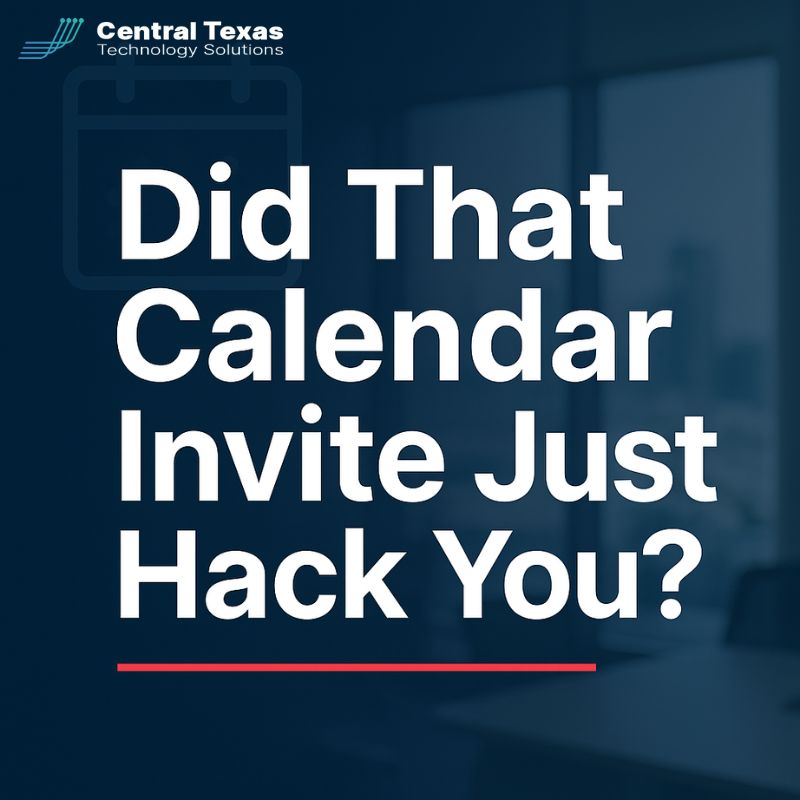
 Your leaders live by the calendar. When bogus invites start appearing and staff click what looks like a routine meeting link, attackers get exactly what they want. Calendar phishing turns trusted notifications into a delivery system for fake login pages, credit card forms, and malware downloads. Because many platforms auto-add invitations, these scams often arrive as legitimate events rather than suspicious emails.
Your leaders live by the calendar. When bogus invites start appearing and staff click what looks like a routine meeting link, attackers get exactly what they want. Calendar phishing turns trusted notifications into a delivery system for fake login pages, credit card forms, and malware downloads. Because many platforms auto-add invitations, these scams often arrive as legitimate events rather than suspicious emails.
Central Texas businesses in Austin, Round Rock, Georgetown, Temple, and the I-35 corridor are moving fast. That pace makes this attack effective. People accept, click, and move on. Attackers count on it.
What's Really at Stake
A single click on a calendar event can hand over email credentials that unlock files, invoices, and contact lists. That opens the door to wire fraud, vendor impersonation, and account takeovers that ripple across your organization and your partners. Recovery brings downtime, incident response costs, legal exposure, and lost client trust. The hidden cost is focus. Every disruptive incident steals attention from growth.
How Attackers Exploit the Calendar
-
Unsolicited invite lands in email.
-
Default settings auto-add the event to the calendar.
-
A convincing title and description create urgency.
-
The event link routes to a phishing site or malware download.
-
Credentials or payment details are harvested, or a device is compromised.
These invites often impersonate Microsoft, Google, shipping companies, or prize notifications. They use short meeting windows and urgent language to rush decisions.
Your Guide in Central Texas
CTTS helps CEOs and operations leaders shut this down without slowing the business. We tune settings in Google Workspace or Microsoft 365, deploy layered email and identity protections, and coach your team so they recognize the pattern in seconds. You get a practical plan that fits how your people already work.
The Plan That Works
Below are non-technical, leader-friendly best practices that close the door on calendar phishing while keeping your team productive.
1. Change the defaults that attackers rely on
Turn off automatic addition of invitations and hide declined events. Require a quick human action before an invite appears on the calendar. In Google Calendar, set Automatically add invitations to Only show invitations to which I have responded. In Outlook, disable automatic processing of meeting requests that bypass the inbox. This one change removes the attacker’s shortcut.
2. Make unknown invites follow the same rule as unknown links
Adopt a simple policy. If you do not recognize the sender or you were not expecting the meeting, do not click links in the event description. Verify with the sender through a separate channel. Add this policy to onboarding, team huddles, and your written handbook.
3. Strengthen identity so one mistake is not catastrophic
Enable multi-factor authentication everywhere, require modern device protections, and review conditional access rules that block risky sign-ins. When an attacker steals a password, these controls stop them from walking in the front door.
4. Upgrade your email and collaboration defenses
Use advanced phishing protection that inspects calendar invite payloads, blocks known bad domains, and flags spoofed senders. Enforce DMARC, SPF, and DKIM so your domain cannot be easily impersonated. Add safe link rewriting and time of click analysis to neutralize malicious redirects.
5. Train with quick, real examples and repeat
Short, quarterly refreshers beat long annual trainings. Show two or three real screenshots of calendar phishing, including fake prize claims and account verification notices. Teach the response script. Pause, verify, report. Celebrate employees who report suspicious invites. Culture is your strongest control.
What Success Looks Like
Your calendar only shows meetings you accepted. Staff know how to spot and report suspicious invites. Email and identity systems catch most attacks before people see them. Incidents drop, and your team can focus on serving clients across Austin, Round Rock, and Georgetown without surprise detours.
Ready to Make This Simple
CTTS will run a focused calendar and invite security check across your Microsoft 365 or Google Workspace tenant, adjust risky defaults, and outline the policy and training steps your managers can roll out in a week. You will know exactly where you stand and what to do next.
Schedule a free strategy session with CTTS to protect your team from calendar phishing and related invite scams. Call 512 388 5559 or visit www.CTTSonline.com.
FAQ
How do I know an invite is suspicious?
Unexpected invitations, generic subjects, unknown senders, prize claims, or links that point to odd domains are common red flags. When in doubt, verify with the supposed organizer using a separate channel.
Will changing auto-add settings slow my team down?
No. People still receive invites and can accept them with one click. That small step removes the attacker’s ability to plant events directly on calendars without interaction.
We already have phishing training. Why is this different?
Calendar phishing bypasses the inbox and lands as a trusted event. Training must include calendar screenshots and a clear rule for handling unknown invites, plus the tenant settings that prevent auto-added events.
Contact CTTS today for IT support and managed services in Austin, TX. Let us handle your IT so you can focus on growing your business. Visit CTTSonline.com or call us at (512) 388-5559 to get started!
